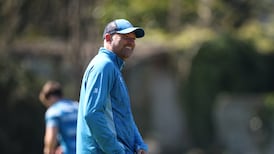Has rugby to regress to ensure its future? It’s a counterintuitive concept, against all of sport’s higher-faster-stronger aspirations. But progress has taken the game to a point where it is getting too big, too strong and too dangerous.
The weekend's Six Nations action once again exhibited what much of elite rugby has become, play after play of superbly conditioned athletes crashing into each other with at times near-heroic levels of commitment.
It is a different species to pre-professional days of 25 years ago. What was once about the creation of space is now about the construction of space through players running tactical lines that effectively make them human wrecking balls.
It doesn’t mean the modern game can’t contain skill and wit and imagination. In fact it highlights even more the breathtaking talents of those rare players able to execute those qualities under the most extreme pressure.
But to employ that most clichéd of rugby euphemisms, those qualities are too often an optional cherry on top of a vast exercise in physicality.
The toll of bigger and stronger not only being an ambition but a requirement is increasingly being pointed out as both unhealthy and unsustainable. Conditioning was supposed to protect players. Instead it has helped make hits harder and the game more brutal.
It’s something the sport eventually has to properly address, not just in terms of current player welfare but in the vital matter of ensuring future generations play the game.
Because how sustainable or healthy can its outlook be with ever increasing awareness of the physical cost involved in playing professionally – especially in relation to concussion – and too often the tragic toll on those aspiring to be pros.
Inevitably when focus turns to rugby’s dangers there is often a knee-jerk reaction to dismiss criticism as hostility from those ignorant of the game’s nuances. But dismissing general perceptions of rugby’s dangers is a cop-out the game can’t afford.
France's daily sports publication, L'Equipe, is hardly in the business of cutting the ground out from underneath its own commercial feet. But in December, after the death of 18-year-old Stade Francais academy player Nicolas Chauvin, it bluntly outlined the reality.
Cardiac arrest
Chauvin was playing for Stade Francais's Under-21 team when he was caught in a two man tackle that broke his neck, caused cardiac arrest and cut off the oxygen supply to his brain. His death was the third linked to rugby in France in 2018 alone.
Dreadful evidence of the tragic toll the game can take when things go wrong is hardly confined to a single country.
It makes rugby’s general future intimately bound up in individual parental quandaries as to whether or not this is a game they’re comfortable with their children playing.
"From now on, we know. And no one can pretend there is still any doubt. Rugby kills," declared the L'Equipe editorial.
“Rugby kills because with professionalisation (sic) a rough game has become a violent game. Rugby kills because it believed that preparation protected everything, that the players’ bodies could take more tackles, could take harder, higher tackles, often made by two defenders simultaneously. Rugby kills because we did not want to see that it could kill,” it added.
It’s the context in which rugby has to address its core evolutionary problem; how a game rooted in contact can dilute that contact enough to make the game safer.
Because dilution is required. Professional players continually putting their bodies through the punishment required to compete at the highest level is incredible. But is it something a lot of parent want their kids to aspire to.
For its own sake rugby needs to return to being a game of evasion rather the collision.
No doubt there are finicky concepts that might help in that direction such as increasing the size of the pitch, reducing the numbers of players on it or are allowed be substituted. There is also the option of weight restrictions at underage level in particular.
But if the root issue is ever increasing size then logically the major solution is to reverse that trend.
No rugby expertise is required to find such a prospect fascinating. It’s a construct against everything elite sport is supposed to be about in terms of perpetual progress. It certainly flies in the face of all those clichés about how standing still really means going backwards.
Real issues
But if moving forwards means even more risk, then standing still to properly examine the very real issues rugby faces must represent some sort of progress.
Certainly with growing awareness of the dangers of concussion, and the inevitability of it occurring in a sport that revolves around impact, it is unrealistic to expect there’s no cost to this obsession with size and power that threatens to make rugby too dangerous for its own good.
That means the game has to figure out what it wants to be. There’s a spectacle in watching huge behemoths colliding with one another. But it has to be asked it is a sustainable spectacle considering the risks involved.
Many within the game will insist such risks are far outweighed by the benefits young players in particular get from playing rugby, as if it is somehow singular from all other sports in terms of character development. But that’s the sort of sidestep we see all too rarely on the pitch.
How to place the priority on skill rather than power is a hugely difficult square to circle for those in authority. Risk can never be eliminated from such a physical game. But rugby is evolving in a way that threatens to cut the ground out from underneath its own feet.
It was once famously a game for all shapes and sizes. Progress means it hasn’t been that for some time. Rugby would do well to try and find a different kind of progress though and also keep in mind how advancement and improvement aren’t synonymous.
















